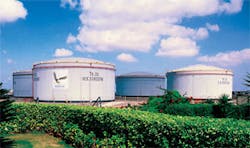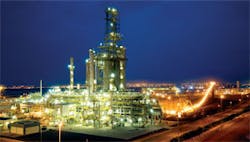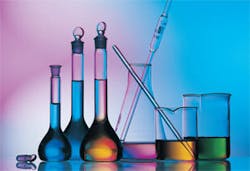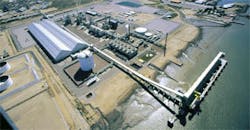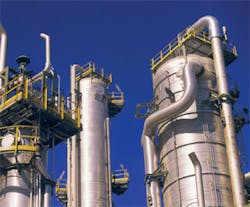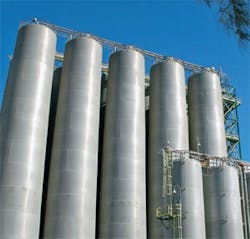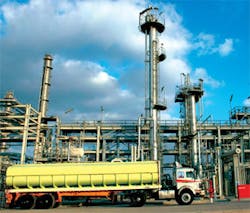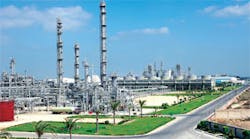Building Egypt’s downstream: Master petrochemical plan, refinery expansion will make a world leader
Economic growth and growing populations will keep global demand for transportation fuels and petrochemical products growing at a brisk pace for the foreseeable future. Meeting that demand will require large investments in additional refining and manufacturing capacity.
To be competitive, that capacity should be located where it is convenient to both feedstock and markets. And it should be capable of producing the high quality, lighter products that world markets increasingly demand.
Egypt’s significant petroleum resourcesespecially its gas reservesand its strategic location make it an attractive place to invest in new capacity. The country’s long term economic and political stability serve to reduce the risk of investment and add another measure of competitive advantage.
With these assetsand its technical expertiseEgypt has a unique opportunity to take a leadership position in meeting tomorrow’s demand for high quality petroleum and petrochemical products.
Kerosene storage tanks. Midor refinery produces LPG, 95 (RON) gasoline, jet fuel and diesel.
To ensure that full advantage is taken of the potential that tomorrow’s markets promise, the Government of Egypt and the Ministry of Petroleum have formulated plans and begun to take action to convert that opportunity into growth for Egypt and products for world markets.
Among those plans and actions are a world-class grassroots refinery, upgrades to existing refineries and a comprehensive petrochemical industry Master Plan.
Refining
As the world’s spare refining capacity continues to shrink, Egypt’s position as a venue for investment in the expansion of existing plants and new facilities becomes increasingly attractive.
Meeting the global need for more refining capacity will focus on sophisticated ‘complex’ capacity to produce the light sweet petroleum products that markets now demand. A more complex refinery also is able to produce more light transportation fuels from cheaper heavy oil, providing a competitive advantage when high crude prices combine with ever more stringent air quality regulations.
Last year, Egypt’s refineries produced about 30.4 million tons of products. Domestic demand for petroleum products in fiscal year 2004/2005 was almost 26.5 million tons and is expected to exceed 27 million tons in the current fiscal year.
Also last year, EGPC began a program to upgrade the capacity of existing plants to 31.4 million metric tons annually, an increase of 1% from the previous year. The company also estimates capacity of existing refineries could be boosted further, perhaps to 35 million tons/year.
The upgrading plan will increase kerosene and jet fuel production by 5% over the previous year and gasoline output by 3%. Production of high value solvents will increase by 10%.
At end of the 2004/2005 year, a variety of upgrading projects were in progress under a detailed plan to maintain capacity, remove bottlenecks and fulfill health, safety and environmental requirements.
Key upgrading projects among Egypt’s refineries included:
- Upgrading a lube oil complex to maintain efficiency and increase production
- Rehabilitation of furnaces to maintain production capacity
- Installing six boilers at three different plants to meet operating steam demands
- Replacing current solvents at three locations to increase lube oil production capacity and meet international specifications
- Building a hypochlorite sodium unit to treat and filter process water
- Installing a hydrogen compressor to meet hydrogen demands
Midor: State of the art
Among Egypt’s nine refineries, the Middle East Oil Refinery (Midor) is one of the most important, said Mr. Nazeem.
Midor is a grass roots refinery with a design capacity of 100,000 barrels per stream day (b/sd) built around eight licensed units. With high conversion capability based on hydrocracking and delayed coking technologies, it is designed to produce LPG, 95 Research Octane Number (RON) gasoline, and jet fuel and diesel that meet Y2005 European specifications.
“Those products represent more than 85% “white” products recovery,” said Mr. Nazeem.
Midor is a grass roots refinery with a design capacity of 100,000 barrels per stream day (b/sd) built around eight licensed units.
Also under study is a capacity increase. “The refinery business has seen the strongest refining margins ever in the last two years and most forecasts indicate a continuation of this trend,” said Mr. Nazeem. An ongoing study to evaluate the most economic expansion scheme indicates that throughput could easily be increased by 20%, he said.
In periods of high oil prices, hydroskimming refineries are the most adversely affected because they convert almost half of the crude barrel into fuel oil. For a complex refinery like Midor, however, crude oil price has much less impact. Rather, it is the ratio of products prices to feedstock (crude) prices that has the largest influence on refinery margin.
To remain competitive, refineries such as Midor must be constantly updated as new technology becomes available. Installation of an advanced process control system is being considered, and other investments in operating and management technology are under study.
“We are always keen to update the tools and software to ensure the best technology is being applied,” said Mr. Nazeem.
Serving the global market
The lack of spare refining capacity has recently made it difficult to meet international product demand. But that market challenge is another opportunity for Egypt’s refining industry, especially for Midor.
The refinery is fulfilling its share of internal demand, said Mr. Nazeem. LPG and diesel are the most crucial products required for domestic consumption and the refinery is dedicating all of its production of those two products to the local market. “Products for the local market meet a very strategic governmental requirement, and the products exported are the ones significantly increasing the value added to the crude processed through the refinery,” said Mr. Nazeem.
The refinery is exporting all of its 95-octane motor gasoline and jet fuel production; product exports account for about 45% of the refinery’s total production.
As far as feedstock goes, more heavy ends remain after distillation of heavier crude than is the case with lighter crude. But heavy crude is much cheaper than light crude. For a complex refinery like Midor, the ability to process heavy crude is an advantage because the bottom of the barrel can be converted to high value products.
“That’s why we always try to maximize the heavy part of our crude diet as long as we remain within the refinery’s design limits,” said Mr. Nazeem. Midor is directly linked to the Sumed pipeline, giving the refinery access to a range of crudes.
Grassroots project
Also in response to the world’s need for more refining capacity, Egypt’s Ministry of Petroleum is considering a grassroots refinery that would be co-located with a major petrochemical complex and have a capacity of 200,000 to 300,000 b/d. The estimated total cost is about $9.5 billion.
According to Petroleum Minister Fahmy, the ambitious project now under study would produce high quality, clean burning transport fuels and petrochemical intermediates meeting the strictest European specifications.
“It is set to be one of the top 20 complexes in the world,” he said.
The complex would include these main elements:
- A sophisticated refinery to produce high quality gas oil, unleaded gasoline, naphtha and kerosene
- Units to produce ethylene and polyethylene, propylene and polypropylene, styrene and aromatics
- A power and steam generation facility;
- Transportation and storage utilities.
This huge complex would offer about 100,000 job opportunities during its 5-year construction and implementation phases, according to Petroleum Minister Fahmy.
The Ministry of Petroleum plans to establish a private holding company to implement the complex, and make it a key element in the development of Egypt’s downstream petroleum capability.
Also in response to growing demand, Ganope established a new petroleum products marketing company, Nile Petroleum Trading Co., which plans to build 25 integrated fuel and services stations in the next five years along the new main roads that connect the Nile side with Oasis and Red Sea areas to support the development of Upper Egypt.
Since it was established to fuel the development of that region, Ganope has boosted the number of its LPG filling stations by 55% and increased its LPG distribution units by 31% to help meet increasing demand, said Eng. Akl, Ganope Chairman.
“And studies for new refinery and petrochemical projects are ready to be implemented when warranted by new oil and gas discoveries in Upper Egypt.” said Eng. Akl.
Construction expertise
“Petrojet has helped execute a number of large modern refineries, including the Assiut refinery and Midor,” said Eng. Dahy.
Established in 1975 to handle the construction of oil, gas and petrochemicals related projects, over the past five years, it has extended its operations outside Egypt with a presence in Libya, Jordan, Sudan, Yemen and Saudi Arabia. New bases are planned in U.A.E. and Qatar.
Petrojet also has executed a number of large gas processing and gas liquefaction plants. It is currently building oil, gas, chemical and petrochemical plants, and has signed contracts recently in Saudi Arabia and Qatar. In petrochemicals, Petrojet currently has a significant role in three projects, one for propylene, one for linear alkyl benzene and a third for a fertilizer plant in Damietta.
Also expected are new LPG and LNG projects as well as new gas transmission pipelines throughout Egypt.
Petrojet also has specialized capabilities including the fabrication of equipment used in refineries, gas plants and industrial plants.
One of the main objectives of the Ministry of Petroleum is to endorse the role and involvement of national companies in national plan projects. “Our plans definitely match and complement the Ministry’s plans,” said Eng. Dahy.
Petrochemical manufacturing
The market for petrochemical products is closely tied to both economic and population trends. Those trends can be cyclical, and the cost of petrochemical feedstock can be even more volatile, making strategic plan that is complete, yet flexible a key to success.
Though feedstock also includes lighter crude oil products, natural gas is increasingly at the heart of the global petrochemical industry’s ability to produce building blocks for everything from plastics to medicine to computers, and materials for products that span from surgical gloves to fertilizer to auto parts.
Petrochemistry has an essential role in offering future generations a more sustainable world through developing new technologies, new materials and new solutions to age-old world problems, according to the European Chemical Industry Council (Cefic).
Petrochemistry has an essential role in offering future generations a more sustainable world.
Because petrochemistry underpins a host of other essential industries, it is an ‘enabling’ industry, according to Cefic. Since it drives innovation in industries such as healthcare, telecommunications, construction and transport, it is central to the pursuit of a sustainable society.
Like refiners, petrochemical producers must keep pace with changingand increasingregulatory requirements. For example, new European Union legislation requires industry to register all existing and future new substances with a new European Chemicals Agency. The Registration, Evaluation and Authorisation of Chemicals (REACH) legislation will take effect in mid 2007. About 30,000 existing substances must be registered within the first 11 years during the phase-in period.
The regulation will affect all substances produced or imported in quantities of 1 ton/year or more.
A long-term strategic plan
Egypt’s petrochemical sector dates to the 1950s when its polyamide unit to produce Nylon-6 became one of the first such production units in world. In the 1970s, fertilizer began to be manufactured from natural gas.
Then over the next two decades, polyvinyl chloride (PVC), polyester, linear alkyl benzene, ethylene, polyethylene and polypropylene were added to Egypt’s petrochemical product slate.
With the rapid growth of the country’s natural gas reserves, a strategic location, and a fast-growing global demand for a wide range of petrochemicals, Egypt now has a special opportunity to take its petrochemical industry to the next level.
To fully exploit that opportunity, the Egyptian Government has crafted a strategic Master Plan to guide development of the country’s petrochemical manufacturing industry. Implementation of the plan will cost an estimated $10 billion over 20 years and create 14 petrochemical complexes producing 15 million tons of products annually.
Though the plan is continuously updated to reflect changes in local and international markets, as now envisioned, it would involve an estimated 24 projects and 50 production units.
Almost 30 million sq m of land in seven areas has been designated for possible petrochemical projects in Alexandria, Beheira, Kafr El Sheikh, Dahkalia, Damietta, Ismailia and Suez. Sites feature access to roads, utilities and local labor and feedstock.
The National Petrochemicals Plan is one of the largest long term strategic development plans in Egypt.
Egypt’s current production of polyethylene, polypropylene and polyvinyl chloride meets a portion of local demand and abundant feedstock will help the industry expand. After completing the Master Plan, the 15 million tons/year of petrochemical products expected to be produced will be worth $7 billion. Imports worth $3 billion will be displaced and exports worth $4 billion generated.
In developing its petrochemical industry, Egypt benefits from its location at the cross roads between three continents and its proximity to these markets. But with a population of more than 70 million, growing domestic demand also adds to the attractiveness of Egypt as a place to invest in petrochemical capacity.
Egypt has a bright petrochemical future for many of the same reasons it has opportunities in other segments of the petroleum industry. It offers: A reliable infrastructure with constant expansion;
- Committed available feedstock at competitive prices throughout project life
- Stable political, economic and legal environments
- An Investment Encouragement Law that includes guarantees and incentives
- Logistical advantage due to its proximity to European, Arab and African markets
- Availability of specialized technical expertise with relatively low labor cost
- Growing market demand
Executing the plan
Egypt’s petrochemicals development plan will be implemented through the Egyptian Petrochemicals Holding Co. (Echem).
“The goal in creating Echem in 2002 was to establish a strong entity capable of carrying out the petrochemical Master Plan, and encourage and promote investment in the petrochemical industry,” said Petroleum Minister Fahmy.
In managing and marketing Egypt’s emerging petrochemicals industry, special attention will be paid to development of the private sector with emphasis on joint ventures and mixed capital companies. Echem will promote the plan to local and international investors and assist and support those investorstechnically, financially and commerciallyin planning, building and operating projects.
“As it pursues its vision to become a major manufacturer and marketer of petrochemical products, Echem will develop a competitive industry based on local human and natural resources using state-of-the-art technology,” said Ms. Moneim El Banna, Echem Chairperson.
Echem’s mission to establish and promote an advanced petrochemical industry will maximize the value added to the country’s petroleum resources and support the national economy, she said.
The Master Plan for Egypt’s petrochemical industry calls for a disciplined approach to each project that involves two phasesproject development and implementation.
Project development begins with an inhouse feasibility study that looks at technology, markets, sites and feedstock. A budget is also outlined and the environmental impact of the project is assessed. This step involves identifying groups of products and selection of the best combination of products along the product chain. Project objectives are assessed and a preliminary technical/economic picture created.
During this phase, the project is promoted to potential investors and a memorandum of understanding (MOU) is executed.
During the implementation phase, a “bankable” feasibility study is conducted and the sponsor group of investors, technology providers and financiers is formed. Front end studies proceed and major agreements are signed for feedstock, product sale, land and consulting services. An EPC contract is also signed and financing is closed. In this execution phase, an important goal is to apply innovative contracts and financing schemes.
Finally, during start up and operation, Echem will evaluate performance tests and support ongoing operations.
Selecting projects
Echem developed an investment methodology to be followed in selecting and prioritizing projects over the period of the Master Plan. The approach is based on models designed to attract foreign direct investment through equity participation by international organizations, or to provide financing through local and foreign institutions. The process involves:
- Detailed feasibility studies conducted by independent consultants to maximize safety of investment, generate credibility with interested parties and facilitate financing
- Providing appropriate project sites that are suitable for future expansion and are convenient to utilities, feedstock and export facilities
- Guaranteed feedstock at competitive prices and long-term off-take agreements to guarantee loan payback
- Providing diversified financing resources
- Participating as an equity partner
- Applying a profitable exit strategy
Echem also is focused on research and development, according to Ms. Moneim El Banna. That effort will develop a new technological base, provide easier implementation of foreign expertise and develop local technological capabilities. Among its R&D activities, Echem will design and operate pilot plants for research purposes.
Echem also plans a new headquarters to cope with the larger staff and workload that will be required by Master Plan projects. It has acquired four acres at New Cairo and hired Enppi and Petrojet to select the architectural design by competition and build the new headquarters.
Monitoring and development
Another of Echem’s goals is to develop the performance of operating petrochemical companies including Egyptian Petroleum Co. (EPC), Sidi Kerir Petrochemicals (Sidpec), and the linear alkyd benzene (LAB) unit of Ameryia Petroleum Refining Co. (APRC).
EPC, established in 1987, produces petrochemical intermediates including PVC, caustic soda, and chlorine gas. During fiscal 2004/2005, it produced 66,000 tons of PVC and exported 27,000 tons of caustic soda. Echem implemented a bankable feasibility study to evaluate the expansion of EPC’s PVC capacity to 240,000 tons/year.
The Sidpec ethylene and polyethylene plant went on stream in 2001 using local natural gas as feedstock. The first olefins producer in Egypt, it replaced ethylene imports that were required for EPC facilities.
Echem acquired 20% of Sidpec from EGPC in May 2005.
APRC’s linear alkyl benzene unit produces LAB for the detergents industry. The company’s capacity of 50,000 tons/year meets about 75% of local demand. Periodic market surveys keep track of LAB demand that will be met with the new 100,000 tons/year facility now being built.
In 2004/2005, petrochemicals imports reached 1 million tons valued at $1 billion. Echem expects projects in Phase I of the Master Plan to provide about 3.5 million tons of petrochemicals annually for export that will be worth about $1.8 billion.
HSE: Top priority
The common thread running through all facets of the Master Plan and its implementation is a commitment to protecting the environment and safeguarding the health and safety of employees, contractors and other involved parties.
Because their diversified operations pose a range of environmental challenges to Echem companies, a top priority has been to develop policies and guidelines that lead to solutions. Echem’s Environmental Management System (HSE-MS) is designed to meet the requirements of local laws and international standards, and to be able to adapt to regulatory changes and the needs of new projects.
Important HSE programs at Echem have trained specialists and liaison officers on change management, HSE-MS, internal audit and trained 90% of Echem’s employees on inhouse fire protection systems. The effort also has prepared all company disciplines for ISO certification and integrated HSE requirements and applications into new projects. The company also monitors the performance of operating companies with monthly visits and meetings.
In addition to completing the first revision of HSE-MS, it helped EPC and Sidpec obtain HSE international accreditation for ISO 14001 and OHSAS 18001.
Key projects
A number of petrochemical projects are in various stages of development in Egypt, with completion dates stretching to 2009. Together, the following projects represent a total investment of more than $4.3 billion:
- A methanol plant at Damietta to cost $650 million will produce 1,260,000 tons/year after it starts up in the fourth quarter of 2009
- Ammonia/urea will also be produced at Damietta in a 1.2 million tons/year, $800 million facility, also scheduled for startup in the fourth quarter 2009
- At Port Said, a $520 million facility to produce 350,000 tons/year of propylene and polypropylene will start up at mid 2008
- Polystyrene production at a $150 million plant set to start up in third quarter 2008 at Alexandria will be 200,000 tons/year
- Also at Alexandria, the EPC contract for a $450 million linear alkyl benzene plant with an output of 100,000 tons/year was awarded in December 2005
- A $70 million acrylic fiber plant completed in early 2006 at Alexandria is designed to produce 18,000 tons/year
- Polyvinyl chloride production at a $35 million plant at Alexandria that will start up in 2008 will be 150,000 tons/year
- After it starts up near the end of 2009, a $1.7 billion polyethylene plant at Coastal Road will be able to produce 750,000-1 million tons/year
In addition to the petrochemical projects now being developed, opportunities for technologies like methanol-to-olefins will also be explored, said Mr. Karara, Gasco Chairman. And a number of fertilizer plants are also possible.
“Obviously, there will be growing demand for gas and petrochemicals in the local markets, and we have to balance all our needs,” he said.
Gas is becoming more and more important in feeding petrochemical projects. “All these projects depend on gas,” said Eng. Eid, “in addition to our gas projects such as gas fractionation and gas liquefaction.”
Ethylene, propylene leader
One of Egypt’s most important petrochemical companies is Sidpec. Organized in 1997 under the country’s law of investment, Sidpec’s main products are ethylene and propylene.
It currently produces about 300,000 tons of ethylene and 225,000 tons of high and low density polyethylene annually. It also has two small plants to produce 50,000 tons of LPG per year and another that produces 10,000 tons of butane.
Sidpec cites several factors that are important to its success, including the availability of natural gas resources in Egypt and a location between Gasco and the Egyptian Power Co. that allows integration of utilities and logistics. It also relies on highly trained personnel and uses the latest technology to comply with environmental regulations.
Working with different providers of proven technology has also been important to Sidpec’s success, according to Mr. Mohamed Nour El-Din, Chairman.
“Inovene technology for polyethylene was unknown in our area, but we started working with ABB Lummus and now our product ‘Egyptene’ is very well known, not only in Egypt but in more than 50 countries around the world,” said Mr. Nour El-Din.
The Egyptene polymer portfolio includes linear low density polyethylene (LLDPE) and high density polyethylene (HDPE).
Sidpec also supplies LPG to sister company Gasco. And Sidpec provides about 40,000-45,000 tons/year to the EPC for use in the production of PVC. The remainder of Sidpec’s LPG output is used in its plant for the production of polyethylene.
About half of Sidpec’s 225,000 tons/year of polyethylene output is exported. Since the production allocated to domestic market does not fully meet demand, the company is considering an expansion that would make it capable of meeting all local demand while maintaining its export volumes.
“Continuing to produce the same volume for export is important in maintaining our reputation in the international market,” said Mr. Nour El-Din. In addition to quantity, quality is of critical importance in acquiring and keeping export markets.
“It’s very important because we export more than 50% of our products,” he said. “If we are not environment friendly, we won’t be successful.”
Beginning at home
Mr. Nour El-Din is also Chairman of a committee comprised of all the industrial companies located in Sidpec’s area that deals with the benefits of the member companies and the surrounding environment.
For example, medical insurance and medical treatment are provided for the people in the area, an especially poor region. Funds are available for schooling and for social services. A medical and educational conference for children is also currently planned.
“We and all the companies in this committee are trying to improve the living conditions in the area,” said Mr. Nour El-Din. “This committee is not only for the petroleum sector companies but for other companies as well.”
Building Egypt’s Downstream 18 “In addition to the petrochemical projects now being developed, opportunities for technologies like methanol-to-olefins will also be explored.”
